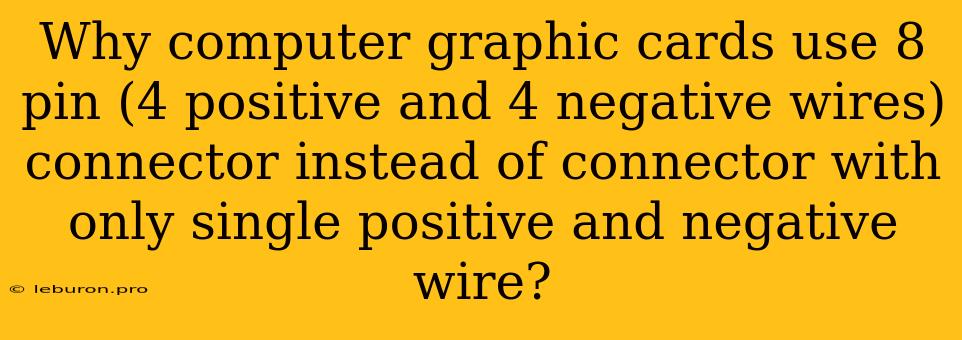Why Computer Graphic Cards Use 8 Pin (4 Positive and 4 Negative Wires) Connector Instead of Connector with Only Single Positive and Negative Wire?
The intricate world of computer hardware often involves components with specialized power requirements. One such component is the graphics card, responsible for rendering the stunning visuals we enjoy on our screens. You might wonder why graphic cards necessitate an 8-pin connector with four positive and four negative wires instead of a simpler single positive and negative wire configuration. This seemingly complex arrangement is actually a clever design choice that ensures optimal power delivery and performance for these demanding components.
Powering the Visual Engine: Understanding the Demand
Graphic cards, particularly those with high-end GPUs, consume significant amounts of power to perform their complex calculations and generate those immersive graphics. A single positive and negative wire configuration, commonly found in standard power supplies, would be insufficient to meet these demanding power requirements. Such a setup would lead to power limitations, instability, and even potential damage to the graphics card.
The Need for a Dedicated Power Rail
The 8-pin connector provides a dedicated power rail for the graphic card, ensuring it receives the necessary voltage and current without compromising the system's overall power distribution. This dedicated rail allows the graphics card to draw the power it needs without being affected by fluctuations in other components' power consumption.
Voltage and Current: The Foundation of Power
Let's break down the importance of the positive and negative wires in the 8-pin connector. The positive wire carries the electrical current from the power supply to the graphics card. This current is essential for powering the card's internal components, including the GPU, memory, and other circuitry. On the other hand, the negative wire serves as the return path for the current, completing the electrical circuit.
Why Four of Each? The Role of Parallel Paths
The presence of four positive and four negative wires is not just a random design choice. These multiple wires act as parallel paths for the current to flow. This parallel arrangement offers several advantages:
- Increased Current Capacity: With multiple paths, the connector can handle a higher overall current flow. This is vital for delivering the power required to handle demanding graphics workloads.
- Reduced Voltage Drop: The parallel arrangement minimizes the voltage drop that occurs when current flows through a wire. A lower voltage drop ensures that the graphics card receives the full intended voltage, leading to improved performance and stability.
- Improved Reliability: The parallel paths create redundancy. If one path experiences an issue, the remaining paths can still carry the current, ensuring uninterrupted operation.
The Benefits of the 8-Pin Connector
The 8-pin connector, with its unique configuration of four positive and four negative wires, provides several key benefits:
- Increased Power Delivery: The dedicated power rail and parallel paths allow for significantly higher power delivery compared to a single positive and negative wire setup. This ensures the graphics card receives enough power for demanding games, rendering, and other graphics-intensive tasks.
- Improved Stability: By providing a dedicated power rail and minimizing voltage drop, the 8-pin connector enhances the stability of the graphics card. This reduces the risk of system crashes, artifacts, and other performance issues that can occur due to inadequate power supply.
- Enhanced Performance: With sufficient power, the graphics card can perform at its optimal levels, resulting in smoother frame rates, improved image quality, and overall enhanced gaming and visual experience.
- Protection for the Graphics Card: The dedicated power rail and robust construction of the 8-pin connector help protect the graphics card from potential damage caused by power surges or fluctuations.
Why Not Stick with a Single Wire Configuration?
You might wonder why designers haven't stuck with a single positive and negative wire configuration, simplifying the process. However, as we've explored, the benefits of the 8-pin connector outweigh the perceived simplicity of a single-wire setup.
- Insufficient Power: A single wire configuration wouldn't provide the necessary power to meet the demands of modern graphics cards, particularly those with powerful GPUs.
- Unreliable Power Delivery: A single wire would be susceptible to voltage drops, instability, and potential damage to the graphics card.
- Performance Bottlenecks: The limited power capacity would create performance bottlenecks, hindering the graphics card's ability to reach its full potential.
The Evolution of Power Connectors: A Journey of Efficiency
The 8-pin connector is a testament to the evolution of power connectors in the world of computer hardware. The increasing power demands of graphics cards have led to innovations in connector design, ensuring adequate power delivery while maintaining stability and performance.
Conclusion: Powering Performance and Innovation
The 8-pin connector, with its four positive and four negative wires, is an essential element in ensuring optimal power delivery for modern graphics cards. This seemingly complex design choice, however, is a testament to the ongoing pursuit of efficiency and performance in the world of computer hardware. By providing a dedicated power rail, minimizing voltage drop, and maximizing power delivery, the 8-pin connector plays a crucial role in unlocking the full potential of these visually demanding components. As graphics cards continue to evolve and demand even more power, we can expect further advancements in connector technology to keep pace with these ever-increasing requirements.
